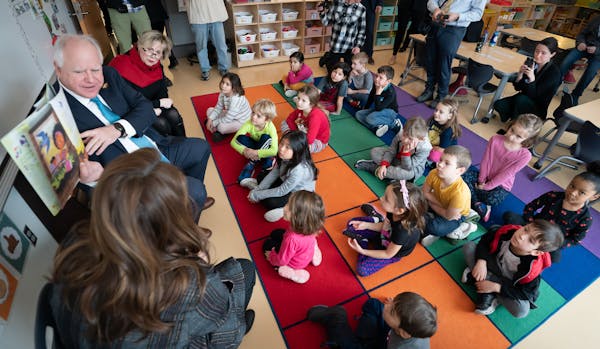After a year of campaign-trail fights over how to tackle violent crime, DFL Gov. Tim Walz is pitching a public safety plan that includes $300 million for local governments.
Walz presented his vision for spending on safety, health and housing Monday, before debuting his full two-year budget on Tuesday. The governor is pushing for nearly $1 billion for housing initiatives, including cash to preserve affordable housing and help people with down payments. He also hopes to act on the long-held goal of opening up the public insurance program MinnesotaCare to allow more people to buy into it.
"This piece of the budget will enhance the ability to have a home, it will enhance the ability to access medical care and it will enhance our public safety professionals and communities," Walz said during a news conference at the Roseville Fire Department.
Clashes over crime permeated last year's campaign-trail politics, particularly in the governor's race where Walz's GOP opponent Scott Jensen made "safe streets" a campaign slogan.
Disagreements over how to address crime were a key point of contention that contributed to the breakdown in negotiations last year between Walz and the then-divided Legislature. Walz had pushed for money for local governments to spend on safety, while Republicans emphasized police recruitment and retention and advocated for tougher penalties.
House Minority Leader Lisa Demuth, R-Cold Spring, said the governor's public safety proposal Monday "comes up dramatically short."
"We need to be focused on getting dangerous criminals off the streets and making sure we are investing adequately in local law enforcement so they have the tools they need to investigate and prevent crimes," Demuth said in a statement.
Democrats, who now control both the House and Senate, are introducing their own public safety efforts. Two gun-control measures were among the first bills introduced this year. The bills would expand criminal background checks for gun transfers and allow law enforcement to temporarily take away someone's firearms.
The governor is pushing for those two measures and other efforts, such as making 21 the minimum age to buy military-style firearms and prohibiting high-capacity magazines. Walz expressed a renewed urgency for the gun-control measures following the mass shooting at a Los Angeles-area ballroom dance club this past weekend.
"When a country has the number of guns and the access to them like we do … the number of shootings are disproportionately higher here," Walz said. "We're going to finally tackle this issue around some common-sense gun [laws]."
The state also would spend $132.5 million on community supervision over the next two years under Walz's plan, dollars intended to help people return to their communities after prison and to prevent recidivism.
But the biggest piece of his public safety spending plan is the $300 million in aid that would go to cities, counties and tribal governments. Walz pressed for that same amount last year. Communities would receive different sums based on their population and could use the money on whatever public safety needs they have.
"You can use that for recruitment and retention. You can use that for better response to mental health crises. You can use it for a whole number of issues," state Department of Public Safety Commissioner Bob Jacobson said. "It gives them local control."
Representatives from the Minnesota Police and Peace Officers Association and the Minnesota Chiefs of Police Association said officer recruitment and retention remains a major issue. They called on state leaders to also provide funding for more police departments to purchase body cameras.
Walz's plan would spend $6 million on law enforcement body cameras and $2 million on corrections officer body cameras.
Housing was another major piece of the governor's proposal Monday. His total "housing stability" proposal — which ranges from homelessness prevention to workforce housing grants — amounts to about $957 million over the next two years. However, he proposed far less for rent assistance than the massive voucher program key DFL legislators would like to see.
"There are parts of the governor's and lieutenant governor's budget that aren't in housing that are going to help families pay their bills," state Housing Commissioner Jennifer Ho said, mentioning Walz's proposal for expanded child-care tax credits.
Similarly, Walz said his proposed $2,000 tax rebate checks for Minnesota families "might be the difference between eviction and not."
"That's why we're asking to put money back into people's pockets," Walz said.
His health spending plan includes $17 million over two years for the MinnesotaCare buy-in to allow more people to enroll in that program, which has long been a goal of the Walz administration and Democratic lawmakers.
"We know that there are still too many Minnesotans who can't afford their health care," including small business owners, self-employed Minnesotans and undocumented immigrants, said House Majority Leader Jamie Long, who is sponsoring that chamber's version of the buy-in measure.
The governor's budget aims to expand kids' eligibility for Medical Assistance, the state's Medicaid program for low-income residents. He also includes tens of millions of dollars in the next two years to improve mental health services, including funds to help children with serious mental health challenges stay at residential facilities.
While state spending on COVID-19 has dwindled, pandemic-related cash remains a piece of Walz's budget as he aims to prevent people from losing health care coverage and put some dollars toward helping long COVID survivors.
Former DFL Senate Majority Leader Kari Dziedzic dies of cancer at age 62

How the Star Tribune is covering the 2024 election

Fact check: Walz and Vance made questionable claims during only VP debate

In Tim Walz's home city, opposing groups watch him debate on the national stage



